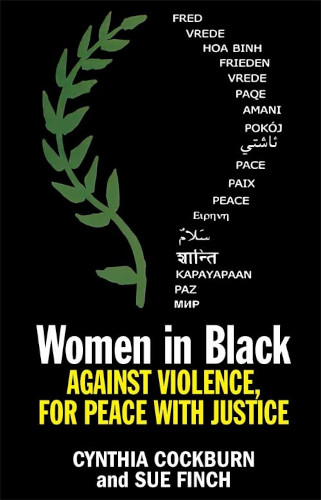I first joined Women in Black (WiB) after the pandemic when people were still cautious about gathering.
Every Wednesday, we stand for an hour at the foot of the Edith Cavell statue in Central London. The passers-by are tourists, school trips, commuters in suits, daredevil cyclists, people dressed-up for a night out, theatre-goers, street homeless.
A few, usually men, react strongly to our standing there, apparently affronted by our call for an end to militarism and war.
Of interest to all peacemakers, this book is both an academic account of and a report on the work of WiB groups all over the world, based on archives and testimonies of individuals.
We learn how, following its emergence in the late 1980s, WiB rapidly became an international network of women standing against militarised patriarchy – each according to their specific contexts.
As one of the testimonies puts it, the central question of WiB is: ‘How do we do peace?’
WiB, Cockburn explains, is founded on a ‘holistic feminism’ that draws a continuum between domestic violence and war: from ‘bedroom to city to continent’.
Also central to the theory behind WiB is the idea of a ‘transversal politics’, developed through research by Cockburn and others, which respects the fact that not everyone shares the same experiences and that we all inevitably come from different positions.
There follows a necessary search for commonality through dialogue rather than through identity or homogeneity.
The stories and reflections in the book show how this transversal politics works in practice – how different groups can work together even when they don’t share the same views.
The first WiB group began in Israel in 1988 during the first intifada, the nonviolent Palestinian uprising against Israeli occupation.
A group of women planned a weekly vigil in Jerusalem, opting to wear black as a sign of mourning. They called for peace negotiations between the Israeli government and the PLO.
A few months later, Jewish women in the US came out to show solidarity, and women from Italy travelled to Israel to learn more and take the vigils to Belgrade.
Chapters on WiB groups in different parts of the world show how each has adapted the ‘formula’ for their own context.
In India, members set up ‘Courts for Women’ that listened to women as they told their stories of suffering.
Reflections from WiB members in the UK give insights into the difficulties of explaining concepts unfamiliar to the general public on a simple placard.
Many of the testimonies report struggles over inclusion but LGBTQ+ inclusion (and trans rights in particular) – important issues in UK – are not mentioned.
I would have liked more detailed explanation of the feminist theoretical roots of WiB and fewer conference reports. (Though the latter contain hints of an important archive.)
By way of hopeful conclusion, the last chapter looks at accounts from members of the most recent WiB group, formed in 2011 in Armenia. The 2020 conflict in Nagorno-Karabakh prompted the young group – even while isolating during the pandemic – to connect, to educate young women in feminist peacekeeping, accompany internal refugees, and make connections across borders.
This contemporary example shows the role of WiB as an international solidarity network that promotes alternative visions for peace.


